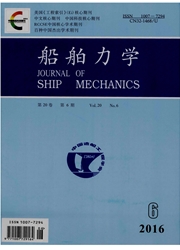

 中文摘要:
中文摘要:
船用螺旋桨工作在低速重负荷工况、或采用大侧斜几何型式或采用复合材料时,其流固耦合现象较为突出,螺旋桨设计中若无法准确考虑其间的水弹性影响,将会造成船机桨失配及实船推进性能的错误预报。文章基于螺旋桨环流理论设计方法、螺旋桨流固耦合算法以及逐步逼近法,形成了一套可考虑水弹性影响的螺旋桨设计方法,重点讨论了流固耦合中水动力载荷更新方式、逐步逼近法中预变形松弛因子的选择对设计结果的影响。通过大侧斜螺旋桨及复合材料螺旋桨设计实例,进一步阐述了在螺旋桨设计中考虑水弹性的必要性,也验证了所开发设计平台的有效性。该设计平台为后续复合材料螺旋桨的优化设计提供了基础。
 英文摘要:
英文摘要:
For marine propellers with highly skewed profile or composite material, or working at low speed heavy load conditions, the effect of Fluid Structure Interaction ( FSI) should be considered in propeller de-sign to avoid mismatching of vessel-engine-propeller and misestimating of full scale vessel propulsion performance. Based on propeller circulatory flow theory, propeller FSI algorithm and successive approxi-mation method, a propeller design method with consideration of hydroelastic effect was proposed, and the influences of renewal mode of hydrodynamic force in FSI and pre-design relax factor on design result were discussed. Finally, a highly skewed propeller and two composite material propellers were designed by plat-form developed to further describe the necessity of considering hydroelastic effect in design of flexible propeller, which also testified the validity of platform. The designed platform could provide a foundation for further study on optimization design of composite propeller.
 同期刊论文项目
同期刊论文项目
 同项目期刊论文
同项目期刊论文
 期刊信息
期刊信息
